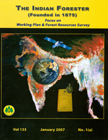Inland Cultivation of Casuarina equisetifolia L. (Jhaw) in South West Bengal
DOI:
https://doi.org/10.36808/if/2007/v133i1/1277Abstract
In South-West Bengal, soil and agroclimatic conditions are not conducive for desirable growth of a wide range of species. Due to over-exploitation, the natural Sal forests were badly degraded in the past. For restoration of tree cover on blanks and degraded lands, which were unfertile, Eucalyptus hybrid and Acacia auriculiformis were introduced during 1960s. Areas which bore live root stock of Sal continued to be managed under 'Coppice with Standard' silvicultural system. While Eucalyptus and A. auriculiformis were found suitable for the region, Silviculture (S) Division of W B Forest Directorate had been trying to find some other species whose performance would be comparable to or better than those two species in terms of quality of use and production potential. With this background, experimental plantation of Casuarina equisetifolia was taken up to assess its performance vis-a-vis that of Eucalyptus and Acacia.Downloads
Download data is not yet available.
Downloads
Published
2007-01-01
How to Cite
Chaudhuri, S. (2007). Inland Cultivation of <I>Casuarina equisetifolia</I> L. (Jhaw) in South West Bengal. Indian Forester, 133(1), 115–119. https://doi.org/10.36808/if/2007/v133i1/1277
Issue
Section
Articles
License
Unless otherwise stated, copyright or similar rights in all materials presented on the site, including graphical images, are owned by Indian Forester.





